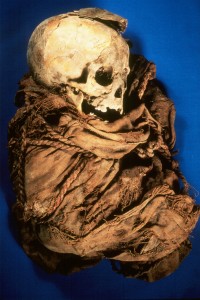Zombies may be trendy right now, but the madness for mummies is eternal.

Coffin of Tahat from Michael C. Carlos Museum at Emory University
That’s what I found out while putting together a Mummy Madness story this week for msnbc.com.
Before I started my research I called my buddy Adam Woog, who wrote a book about mummies for the middle-school market. “Mummies are creepy and cool,” he told me. “Everyone knows about Egyptian mummies. Make sure you write about mummified people that have been discovered in deserts, on icy mountains, in bogs and other places. That’s part of what makes mummies so mysterious.”
He’s right. Mummies are mysterious. And, William Jamieson told me, “Mummies sell tickets.” Jamieson is a Toronto-based dealer and collector of ancient and tribal artifacts who’s sold mummies (and shrunken heads!) to museums and attractions around the world. During the late 1800s and early 1900s in North America, he says, “You couldn’t even really call yourself a museum unless you had a mummy.”
So that’s why, in addition to the museums around the world that have multiple mummies, you’ll find ‘one-off’ mummies in places like the Berkshire Museum in Pittsfield, Massachusetts and the Charleston Museum in Charleston, South Carolina.
Have you been meaning to meet some mummies? Then consider adding these museums and attractions to your travel plans.

Cat mummy from the British Museum
Both kids and adults visiting London’s vast British Museum usually make a beeline for Rooms 62-64. One of the world’s largest collection of Egyptian mummies and their coffins is displayed here along with funerary masks, mummified cats, fish and other animals, as well as other objects once buried with and associated with the dead.

Accidental Mummies of Guanajuato exhibition
On exhibit at Mexico’s Mummy Museum of Guanajuato (Museo de las Momias de Guanajuato) are more than 100 naturally preserved mummies exhumed from a municipal cemetery between 1865 and 1989. The mummies are displayed in themed groupings that include baby mummies (including what may be the world’s smallest mummy), mummies still dressed in complete burial outfits, and the mummies of people whose lives clearly ended tragically.
Thirty-six mummies from the Guanajuato museum’s collection are now part of an exhibit scheduled to tour the United States through 2012. Called the “ Accidental Mummies of Guanajuato,” the exhibition closed its run at the Detroit Science Center in May. The next stop on the tour should be announced shortly.

Egyptian Galleries at Michael C. Carlos Museum
In Atlanta, the Michael C. Carlos Museum at Emory University displays some of the 10 coffins and nine mummies it purchased from Canada’s Niagara Falls Museum, which began exhibiting Egyptian mummies in the 1850s and went out of business in the 1990s. “Ulysses S. Grant, Teddy Roosevelt, Abraham Lincoln and P.T. Barnum saw those mummies,” says Peter Lacovara, curator of the Michael C. Carlos Museum, “And they are some of the earliest mummies exhibited outside of Egypt.” In addition to three or four mummies in their own coffins, the museum currently displays animal mummies, including a crocodile, a cat and a hawk, and coffins created for a lizard, an ibis, a snake and a shrew.

Mummy on display at San Diego Museum of Man
Multiple mummies are also on display at the San Diego Museum of Man. In addition to replicas of “Bog Bodies” from Denmark and “Chinchorro Mummies” from coastal Chile and Southern Peru, the museum displays two authentic Egyptian mummies on loan from the Los Angeles County Natural History Museum, five naturally mummified bodies from Peru (four are children; the fifth is a young woman) and a female mummy from Mexico who was seven to eight months pregnant at the time of death.

Mummified head from Mummies of the World.
The California Science Center in Los Angeles doesn’t have any mummies in its own collection, but it is currently partnering with 20 other museums from around the world to exhibit the mummies (or mummified body parts) of 45 humans and animals, along with about 100 mummy-related artifacts from South America, Europe, Asia, Oceania And Egypt.
“The Mummies of the World exhibit focuses on the scientific research and analysis being done on these mummies,” says the Science Center’s Diane Perlov, but it’s clearly the Peruvian child mummy dating to 3,000 years before King Tut, the 18th century mummified family (a son and his parents) and the other “Ew-I-can’t-look-but-I-can’t-look-away” mummies that people are lining up to see.
The exhibit will stay in Los Angeles through November and then move on to Milwaukee, where the mummies will be on display through May 2011.
Have you seen a mummy on display in your travels? Tell us about it below.